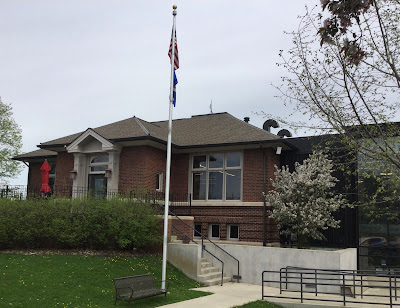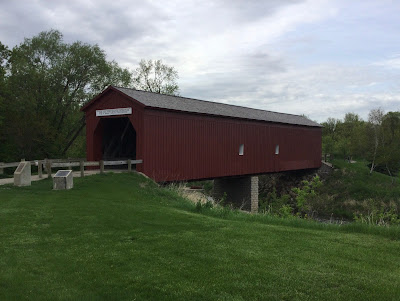
It was a relief to discover that the fourth I came upon, the Buffalo Shores Recreation Area, a county campground, didn’t take reservations. It operated on the old-style, first-come-first-served basis. Once one claimed a site, they could hold it for fourteen days, so there were people who had come early to stake out a site, paying for a few extra days, and then leaving.
Half of its sixty-five sites already had been tagged through the weekend, even though they weren’t occupied. The campground hosts couldn’t guarantee that if Janina and I showed up Friday, when Janina will be driving in from Chicago, that any sites would be left. I could chance returning on Thursday in two days, but that was a bit iffy too. Maybe I’d come back Wednesday, the next day, and hang out for two days before Janina’s arrival.
I had a couple of other options to check on before having to make that decision. I went on-line to see the camping situation at the large Mississippi Palisades Park halfway between Moline and Galena that we had stayed at before. Two of its 165 sites were still available. I clicked fast to book one before anyone else beat me to it, only to learn they were special handicap-accessible sites only available to the handicapped.
Next I tried an Army Corps of Engineers campground just north of Moline. And bingo, it had several sites available and there were no catches. What a relief. I didn’t have to sweat out going back to the county campground ten miles south of Davenport, and Janina didn’t have to remain in suspense of whether or not her escape from the city would be derailed. We could be happy that we’d be spending the holiday camping. And we could also be happy that so many others had a similar desire, almost enough to give one hope for the future of mankind.
I could have a stress-free two days hanging out in the Quad Cities resting my legs and reading awaiting Janina, who couldn’t come any earlier as she didn’t want to miss her Thursday University of Chicago class on the German philosopher Ludwig Wittgenstein.
I had been wanting to get to Moline for awhile, as its library is just one of a handful of libraries in the US that has the cycling memoir, “The Wind at My Back: A Cycling Life,” by the English novelist Paul Maunder published in 2018. Maunder is a regular contributor to the highly literate cycling magazine “Rouleur.” I am always happy to see his by-line, and evidently many others are too as worldcat.org, a website that is an archive of the holdings of libraries all over the world, listed libraries in Australia, New Zealand, Singapore, Germany and cycling-mad Slovenia with copies of his book.

Fortunately the book was on the shelf allowing me a fine day immersed in its 259 pages. Unfortunately, I didn’t have the pleasure at Moline’s grand downtown Carnegie, as it had been replaced in 2005 by a sprawling two-story library on the outskirts of the city with all sorts of amenities including a pair of exercycles with trays to lay a book upon and read while one pedals away. I could hardly object to the setting and the consciousness of the librarian who had acquired “The Wind at My Back.”
Much as the book is about his life as a cyclist, beginning with riding with his father and his friends when he was but ten, it is as much about his life as a writer . He acknowledged that he identifies himself as a novelist, though none of his four novels have found a publisher, a startling revelation. He was forty-three when he wrote this memoir and had only stumbled into writing about cycling a few years before when a friend suggested he try his hand at it. And there he found his niche.
In his teens when he took up racing he had the ambition of becoming a professional cyclist. At nineteen he realized he didn’t have the ability for that and hardly biked at all while at university, devoting his leisure time to attending raves and doing drugs. He resumed cycling after college and realized it defined who he was. When he spoke all too much about cycling at his writer’s group, someone asked if he’d rather be a writer or a professional cyclist. Without hesitation he replied cyclist.” He has fully come to terms that he failed at that as well as at becoming a novelist and winning the Booker Prize, as he’d initially hoped.
The book was much less of a full-on cycling memoir than I was anticipating. Whole swaths of his cycling life are overlooked. He mentions Greg LeMond was his hero, but leaves it at that. He hardly writes about his racing career, only the race in the summer of 1992 he dropped out of, never racing again.
There is no mention of his first race or any of his wins or what made him think he could represent England at the world championships. It’s not until page 195 that he mentions a cycling holiday in France as an eleven-year old with his family. His father rode a tandem with his younger sister while his mother completed their foursome on a bike of her own.
His father surprised him by intersecting with the Dauphiné-Libéré, a week-long pre-Tour de France race, where he’s thrilled to get his picture taken with two of the stars of the time, the Australian Phil Anderson and Irishman Stephen Roche. He tells Roche he’d like to ride the Tour de France some day. Roche told him he had the same ambition when he was his age.
There’s not a single mention of Merckx or Coppi or Anquetil or much of the lore of the sport that cycling memoirs generally pay homage to. He grants a couple sentences to Henri Desgrange, founder of The Tour, and his intent to make it a test of human endurance, but gives him short shrift too. As fine a writer as Maunder can be, he could have woven more of the sport’s past into his narrative and given that past new meaning.
He is most fascinated by climbers rather than sprinters but gives no mention of two of the greatest climbers (Pantani and Gaul) and how they and many others of the climbing set became tragic figures. He lumps in Indurain, Ullrich and Armstrong as strong riders who didn’t have the flair of the climbers, so failed to capture his imagination, and that is all he has to say of them. Nor is there a peep on the drug-taking side of the sport. As worthwhile as much of the book is, its failure to be as comprehensive as it could have been may be at the root of why none of his four novels have been published.















































